
Bombs over Exeter - the darkest day
Page added 26 October 2009 - please click on a photo to enlarge
Most of the photographs on this page are from The Story of the Exeter Blitz published by Wheatons, circa 1945, and the Exeter Phoenix by Thomas Sharp also circa 1945.
Back to Photo Essays
 This is believed to be the only
photograph taken during the 4th May 1942 blitz. Taken from the top
floor of the Rougemont Hotel, it shows the glow from the fires
illuminating the billowing smoke, with the Cathedral in the centre. The
glow on the right corresponds with the Lower Market and top of Fore
Street, while that on the left with Bedford Circus and the High Street. Courtesy Isca Photographic Collection.
This is believed to be the only
photograph taken during the 4th May 1942 blitz. Taken from the top
floor of the Rougemont Hotel, it shows the glow from the fires
illuminating the billowing smoke, with the Cathedral in the centre. The
glow on the right corresponds with the Lower Market and top of Fore
Street, while that on the left with Bedford Circus and the High Street. Courtesy Isca Photographic Collection.
 This photograph was taken in the late
afternoon of the 4th May. The National Fire Service had been fighting
fires for about 16 hours when the call went out "send Turntable Ladder immediately to
Colsons - relay will be available on arrival", as fires from
Catherine Street had spread into the store. Here, a turntable ladder is
used to direct water into the top floor of the building. It is said,
that a 4ft 6in (135 cm) thick cob wall saved most of the store by
holding back the flames.
This photograph was taken in the late
afternoon of the 4th May. The National Fire Service had been fighting
fires for about 16 hours when the call went out "send Turntable Ladder immediately to
Colsons - relay will be available on arrival", as fires from
Catherine Street had spread into the store. Here, a turntable ladder is
used to direct water into the top floor of the building. It is said,
that a 4ft 6in (135 cm) thick cob wall saved most of the store by
holding back the flames.
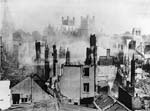 It is
difficult to be precise about where this photographs was taken, but the
position of St Mary Major Church, the Cathedral and the tower
of the Sacred Heart Church suggest it would have been from a tall
building such as Evans Gadd in Smythen Street. If so, the smoking
ruins are in Market Street, Guinea Street, George Street and across the
rear, in front of the Cathedral, South Street. Photo English Heritage.
It is
difficult to be precise about where this photographs was taken, but the
position of St Mary Major Church, the Cathedral and the tower
of the Sacred Heart Church suggest it would have been from a tall
building such as Evans Gadd in Smythen Street. If so, the smoking
ruins are in Market Street, Guinea Street, George Street and across the
rear, in front of the Cathedral, South Street. Photo English Heritage.
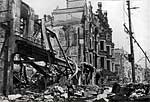 William Brock and
Cornish's survived the onslaught on Fore Street. Beyond is
North Street to the left, and St Peter's Corner. The girders and
twisted metal is now British Home
Stores.
William Brock and
Cornish's survived the onslaught on Fore Street. Beyond is
North Street to the left, and St Peter's Corner. The girders and
twisted metal is now British Home
Stores.
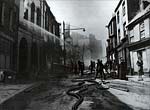 At
the other end of the City, Paris Street was very badly damaged.
Fire-fighters struggled to contain the flames at the top of the street,
and they used the Elim Pentecostal Church as a fire-break, to prevent
the flames spreading. On the other side of the street, water is
directed on the premises below the Palladium Cinema, which had closed
at the beginning of the war to be used for some 'national purpose.' The
Palladium was gutted.
At
the other end of the City, Paris Street was very badly damaged.
Fire-fighters struggled to contain the flames at the top of the street,
and they used the Elim Pentecostal Church as a fire-break, to prevent
the flames spreading. On the other side of the street, water is
directed on the premises below the Palladium Cinema, which had closed
at the beginning of the war to be used for some 'national purpose.' The
Palladium was gutted.
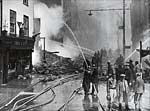 Further down Fore Street
– all the shops from Stone
& Son, past Mary Arches Street up to just before Cornish's corner were lost. Fire-fighters
are shown playing their hoses over the World Stores grocery on the
corner of Mary Arches Street. The prominent eagle with spread wings can
be seen over the shop front of Stones, which sustained serious damage.
Stones relocated to Mary Arches Street after the blitz.
Further down Fore Street
– all the shops from Stone
& Son, past Mary Arches Street up to just before Cornish's corner were lost. Fire-fighters
are shown playing their hoses over the World Stores grocery on the
corner of Mary Arches Street. The prominent eagle with spread wings can
be seen over the shop front of Stones, which sustained serious damage.
Stones relocated to Mary Arches Street after the blitz.
 The Cathedral Dairy was a prominent
business in Eastgate from before the First War, establishing
itself
with visiting tourists for supplying Devon Clotted Cream. At the
outbreak of the Second War it had been taken over by the Exeter
Co-operative. The photograph from inside the shop shows, through the
burnt and smashed windows, the Savoy Cinema and the Plaza Cinema opposite. The Savoy sustained minor damage, but the Plaza was gutted by
a fireball, when it sustained a direct hit. Ironically, the façade
barely looks damaged.
The Cathedral Dairy was a prominent
business in Eastgate from before the First War, establishing
itself
with visiting tourists for supplying Devon Clotted Cream. At the
outbreak of the Second War it had been taken over by the Exeter
Co-operative. The photograph from inside the shop shows, through the
burnt and smashed windows, the Savoy Cinema and the Plaza Cinema opposite. The Savoy sustained minor damage, but the Plaza was gutted by
a fireball, when it sustained a direct hit. Ironically, the façade
barely looks damaged.
 The
twisted ironwork of Bobby's, indicates
how lucky St Stephens Church was to escape serious damage. However, a fire in the tower caused the
bells to fall and smash. During restoration in July 2007, it was
discovered that incendiaries had also set the roof timbers on fire
– it is thought that they smouldered for many months, turning the
timber into charcoal, before the fire extinguished itself.
The
twisted ironwork of Bobby's, indicates
how lucky St Stephens Church was to escape serious damage. However, a fire in the tower caused the
bells to fall and smash. During restoration in July 2007, it was
discovered that incendiaries had also set the roof timbers on fire
– it is thought that they smouldered for many months, turning the
timber into charcoal, before the fire extinguished itself.
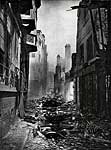 Behind St Stephens, Colsons and Bobbys,
was Catherine Street. Full of small, plaster and lath buildings,
including the Country Inn and Catherines Almshouses, the
incendiaries soon did their nasty work. Fire spread from building to
building, destroying everything in its path. It took 16 hours to reach
Colsons.
Behind St Stephens, Colsons and Bobbys,
was Catherine Street. Full of small, plaster and lath buildings,
including the Country Inn and Catherines Almshouses, the
incendiaries soon did their nasty work. Fire spread from building to
building, destroying everything in its path. It took 16 hours to reach
Colsons.
 In Bedford Street were
two banks, side by side – Barclays and Martins – both
destroyed. This
photograph shows Martins Bank which was on the corner of Catherine and
Bedford Street. The railings to the left are those for the entrance to
the underground toilets in Bedford Street.
In Bedford Street were
two banks, side by side – Barclays and Martins – both
destroyed. This
photograph shows Martins Bank which was on the corner of Catherine and
Bedford Street. The railings to the left are those for the entrance to
the underground toilets in Bedford Street.

 The Cathedral sustained some very
serious damage. Not only were windows blown out (although the great
west window had been removed at the outbreak of war) but St James
Chapel was badly damaged, along with two buttresses. It has been
calculated that if any more buttresses had been destroyed, that much of
the Cathedral roof would have collapsed.
The Cathedral sustained some very
serious damage. Not only were windows blown out (although the great
west window had been removed at the outbreak of war) but St James
Chapel was badly damaged, along with two buttresses. It has been
calculated that if any more buttresses had been destroyed, that much of
the Cathedral roof would have collapsed.
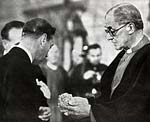 The interior
damage to the Cathedral was distressing, with damaged stonework,
windows and fittings. The King was shown a prayer book which had
assumed the shape of a tennis ball due to a bomb blast. Later, the
Mayoress, Mrs Glave-Saunders gave a present to the King, who remarked "We will not have it wrapped up;
we must save paper." As the couple left via St David's Station
the King remarked "I think the spirit
of the people in Exeter is wonderful."
The interior
damage to the Cathedral was distressing, with damaged stonework,
windows and fittings. The King was shown a prayer book which had
assumed the shape of a tennis ball due to a bomb blast. Later, the
Mayoress, Mrs Glave-Saunders gave a present to the King, who remarked "We will not have it wrapped up;
we must save paper." As the couple left via St David's Station
the King remarked "I think the spirit
of the people in Exeter is wonderful."
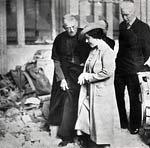 The Queen is being shown some of the damage
to the Cathedral. The Royal couple visited the City on Friday the 8th
May, and were shown around the Cathedral by the Bishop of Exeter and
the Dean. When shown a bomb splinter she said "I hope we give it them back." Later
in the visit, the Queen remarked "I
hear the people were magnificent... I have been in a London blitz, but
this seemed worse because it was so concentrated".
The Queen is being shown some of the damage
to the Cathedral. The Royal couple visited the City on Friday the 8th
May, and were shown around the Cathedral by the Bishop of Exeter and
the Dean. When shown a bomb splinter she said "I hope we give it them back." Later
in the visit, the Queen remarked "I
hear the people were magnificent... I have been in a London blitz, but
this seemed worse because it was so concentrated".
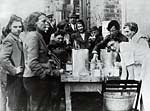 Women
and children queue for tea from a table set up in the street. It was
probably run by members of the Womens Voluntary Service for Civil
Defence (now WRVS), which had been set up in 1938 by Stella Isaacs,
Marchioness of Reading, at the behest of the government. Immediately after the
Exeter blitz, a civilian feeding station was set up in Bury Meadow
– see Bury Meadow video.
Women
and children queue for tea from a table set up in the street. It was
probably run by members of the Womens Voluntary Service for Civil
Defence (now WRVS), which had been set up in 1938 by Stella Isaacs,
Marchioness of Reading, at the behest of the government. Immediately after the
Exeter blitz, a civilian feeding station was set up in Bury Meadow
– see Bury Meadow video.
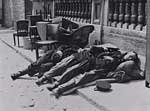 National
Fire Service personnel lie exhausted on the pavement before resuming
fire fighting. It wasn't until 12.30 on the 7th May that all
reinforcements were stood down - 195 Reinforcing Pumps and 1,080
personnel were used during the raid and aftermath to fight the many
fires. Photo English Heritage.
National
Fire Service personnel lie exhausted on the pavement before resuming
fire fighting. It wasn't until 12.30 on the 7th May that all
reinforcements were stood down - 195 Reinforcing Pumps and 1,080
personnel were used during the raid and aftermath to fight the many
fires. Photo English Heritage.
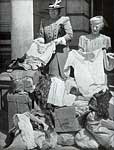 The Mayoress, Mrs Glave-Saunders
organised many events during the war years for the relief of evacuees,
comfort for the troops and to raise money for munitions. Here, she is
shown with donated clothing to be given to those who had lost
everything during the night of the 4th May.
The Mayoress, Mrs Glave-Saunders
organised many events during the war years for the relief of evacuees,
comfort for the troops and to raise money for munitions. Here, she is
shown with donated clothing to be given to those who had lost
everything during the night of the 4th May.
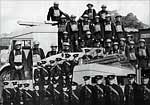 This is a paste up of group photographs of
National Fire Service personnel that appeared in The Story of the Exeter Blitz,
which was published by Wheatons during the war. Fire crews from
Plymouth, Taunton, Torquay and even one from Reading drove to Exeter,
on poorly maintained roads, to assist the local fire service to douse
the flames.
This is a paste up of group photographs of
National Fire Service personnel that appeared in The Story of the Exeter Blitz,
which was published by Wheatons during the war. Fire crews from
Plymouth, Taunton, Torquay and even one from Reading drove to Exeter,
on poorly maintained roads, to assist the local fire service to douse
the flames.
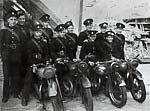 It was important to maintain contact
between the units fighting the fires, the city control centre and the
regional control centre, when the telephone lines were down. These
young despatch riders were used to carry messages requesting more
equipment or personnel, or cancelling requests previously made as the
situation stabilised. A contingent of boys on bicycles were often
the only people who could get through the bomb damaged streets.
It was important to maintain contact
between the units fighting the fires, the city control centre and the
regional control centre, when the telephone lines were down. These
young despatch riders were used to carry messages requesting more
equipment or personnel, or cancelling requests previously made as the
situation stabilised. A contingent of boys on bicycles were often
the only people who could get through the bomb damaged streets.
 A much published photograph showing the
Cathedral across a flattened Bedford Circus, with the High Street
running diagonally across the frame. The GPO building occupied the plot
of land on the other side of the High Street, left of frame. The
building extreme right is the Westminster Bank. The photograph was
taken several months after the raid as the stumps of smashed buildings
and rubble have been removed.
A much published photograph showing the
Cathedral across a flattened Bedford Circus, with the High Street
running diagonally across the frame. The GPO building occupied the plot
of land on the other side of the High Street, left of frame. The
building extreme right is the Westminster Bank. The photograph was
taken several months after the raid as the stumps of smashed buildings
and rubble have been removed.
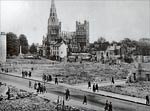 Another
photograph taken several months after the raid, showing a view of St
Mary Major Church and the Cathedral from the top of a building
somewhere off Fore Street (probably in Mary Arches Street). The
main road is Fore Street, with the little street, at right angles, Milk
Street. Now of course, you would see the Famous, Jessops and the
Chevalier Inn on the opposite side of Fore Street.
Another
photograph taken several months after the raid, showing a view of St
Mary Major Church and the Cathedral from the top of a building
somewhere off Fore Street (probably in Mary Arches Street). The
main road is Fore Street, with the little street, at right angles, Milk
Street. Now of course, you would see the Famous, Jessops and the
Chevalier Inn on the opposite side of Fore Street.
 Perhaps
two thirds of Sidwell Street was destroyed that night. The buildings
between the Duke of York and Old Tiverton Road largely escaped,
including the Odeon. However, a direct hit
on a shelter in the middle of Sidwell Street, by the Odeon, caused some
blast and shrapnel damage to the cinema. The steps into the Odeon still
have missing chunks due to the bomb. Sylvia Hart remembers 'Exeter was not Exeter anymore. You could
stand by the Guildhall and see the Odeon Cinema.' This was a
distance of almost ¾ of a mile of devastated High Street and
Sidwell Street.
Perhaps
two thirds of Sidwell Street was destroyed that night. The buildings
between the Duke of York and Old Tiverton Road largely escaped,
including the Odeon. However, a direct hit
on a shelter in the middle of Sidwell Street, by the Odeon, caused some
blast and shrapnel damage to the cinema. The steps into the Odeon still
have missing chunks due to the bomb. Sylvia Hart remembers 'Exeter was not Exeter anymore. You could
stand by the Guildhall and see the Odeon Cinema.' This was a
distance of almost ¾ of a mile of devastated High Street and
Sidwell Street.
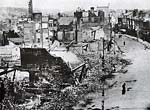 The
city end of Sidwell Street, by London Inn Square, was largely
destroyed, as this photograph testifies. Nothing remained of the White
Lion Hotel and Standfield and White. Now of course, there is the John Lewis store and Sainsbury on this site.
The
city end of Sidwell Street, by London Inn Square, was largely
destroyed, as this photograph testifies. Nothing remained of the White
Lion Hotel and Standfield and White. Now of course, there is the John Lewis store and Sainsbury on this site.
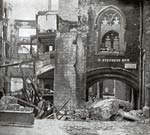 To the left is the destroyed Bobbys,
and
on the right, St Stephens Bow. The bow survives, and is a reminder of a
medieval Exeter that has stood for at least 700 years.
To the left is the destroyed Bobbys,
and
on the right, St Stephens Bow. The bow survives, and is a reminder of a
medieval Exeter that has stood for at least 700 years.
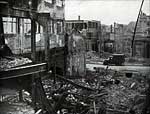 Another view of
St Stephens Bow, although it is more difficult to find. It can be
glimpsed in the middle left of the photograph, which is taken from the
dangerous rear wall of Bobbys, that still stood. The High Street is
beyond, with the remains of the Commercial Union building to
the right.
Another view of
St Stephens Bow, although it is more difficult to find. It can be
glimpsed in the middle left of the photograph, which is taken from the
dangerous rear wall of Bobbys, that still stood. The High Street is
beyond, with the remains of the Commercial Union building to
the right.
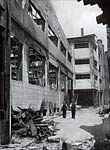 The previous photograph was taken from
the top of these gutted remains of Bobbys, in Catherine Street.
Opposite Catherines Almshouses, what appeared to be a Victorian shop
front on the High Street, had this modern, concrete and steel rear. The
concrete survived, but the building didn't.
The previous photograph was taken from
the top of these gutted remains of Bobbys, in Catherine Street.
Opposite Catherines Almshouses, what appeared to be a Victorian shop
front on the High Street, had this modern, concrete and steel rear. The
concrete survived, but the building didn't.
 Catherines
Almshouses, Chapel and the Country House Inn were all destroyed by fire. St
Catherines Chapel was undamaged at midday, but by the evening it was a
gutted wreck – James Bell wrote "I
remember going into the Chapel, in Catherine Street at 12 noon on the
4th May 1942, walking around and sitting in the pews, There was no sign
of the fire which eventually destroyed it - the building next to it was
on fire. I was only ten years old! It always raises a wry smile when I
read the inscription in the ruins of the St Catherine's Chapel -
'Destroyed by Enemy Action - May 1942'."
Catherines
Almshouses, Chapel and the Country House Inn were all destroyed by fire. St
Catherines Chapel was undamaged at midday, but by the evening it was a
gutted wreck – James Bell wrote "I
remember going into the Chapel, in Catherine Street at 12 noon on the
4th May 1942, walking around and sitting in the pews, There was no sign
of the fire which eventually destroyed it - the building next to it was
on fire. I was only ten years old! It always raises a wry smile when I
read the inscription in the ruins of the St Catherine's Chapel -
'Destroyed by Enemy Action - May 1942'."
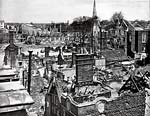 This
photograph also appears to have been taken by a photographer risking
his life scrambling up the ruins of buildings in Catherine Street, in
this case Colsons. In the centre can be seen the bell tower of St
Catherines Chapel, to the right, part of Bedford Circus and in the
rear, the distinctive ribs of the Bedford Garage and to the left, Bampfylde House.
This
photograph also appears to have been taken by a photographer risking
his life scrambling up the ruins of buildings in Catherine Street, in
this case Colsons. In the centre can be seen the bell tower of St
Catherines Chapel, to the right, part of Bedford Circus and in the
rear, the distinctive ribs of the Bedford Garage and to the left, Bampfylde House.
 At 2.43 am
on the morning of 4th May, a 250 kg bomb fell
directly on St Sidwells Church,
destroying it and knocking out the
water main in the area. The tower did not collapse, but it was so badly
damaged, that it was pulled down by sappers, soon after. This
photograph was taken some time after the raid as the tower is not
evident.
At 2.43 am
on the morning of 4th May, a 250 kg bomb fell
directly on St Sidwells Church,
destroying it and knocking out the
water main in the area. The tower did not collapse, but it was so badly
damaged, that it was pulled down by sappers, soon after. This
photograph was taken some time after the raid as the tower is not
evident.
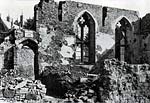 South
Street was also badly damaged with one of the most ancient buildings in
the City suffering destruction – the Hall of the Vicars Choral had sumptuous, oak lined inside walls. The photo indicates that
nothing of the interior survived. The ruins have been, along with those
at St
Catherines, retained as a memorial to the 1942 blitz.
South
Street was also badly damaged with one of the most ancient buildings in
the City suffering destruction – the Hall of the Vicars Choral had sumptuous, oak lined inside walls. The photo indicates that
nothing of the interior survived. The ruins have been, along with those
at St
Catherines, retained as a memorial to the 1942 blitz.
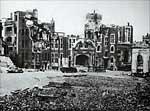 The much lamented Dellers, the Café of the West was
badly damaged during the 4th May. It is thought that oil in the
kitchens contributed to the inferno that swept through the building.
Although only dating from 1916, Dellers was much loved, with many
thinking that the building could have been saved and restored to its
former glory.
The much lamented Dellers, the Café of the West was
badly damaged during the 4th May. It is thought that oil in the
kitchens contributed to the inferno that swept through the building.
Although only dating from 1916, Dellers was much loved, with many
thinking that the building could have been saved and restored to its
former glory.
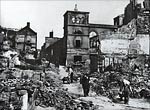 Charles
Fowlers Lower Market Hall off Fore Street was a centre of life in
Exeter for many small traders and farmers. Dating from December 1836,
the blitz did not spare the
building and it was gutted. The walls, and corner towers remained until
they were demolished for Georges Hall (Corn Market). St
Anne's Well Brewery occupied cellars under the Lower Market from 1872,
until June 1953 when the building was demolished. The Lower Market
cellars were the largest private bonded store in the West of England.
Charles
Fowlers Lower Market Hall off Fore Street was a centre of life in
Exeter for many small traders and farmers. Dating from December 1836,
the blitz did not spare the
building and it was gutted. The walls, and corner towers remained until
they were demolished for Georges Hall (Corn Market). St
Anne's Well Brewery occupied cellars under the Lower Market from 1872,
until June 1953 when the building was demolished. The Lower Market
cellars were the largest private bonded store in the West of England.
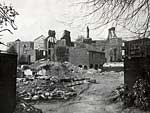 Two important, ancient buildings were
lost in Cathedral Close. The Abbots Lodge and Choristers School were
favourite buildings for tourists to visit. This view from Cathedral
Close shows that nothing remained, while the rear of the burnt out
Bedford Circus, and the Bedford Chapel, left, can be clearly seen.
Two important, ancient buildings were
lost in Cathedral Close. The Abbots Lodge and Choristers School were
favourite buildings for tourists to visit. This view from Cathedral
Close shows that nothing remained, while the rear of the burnt out
Bedford Circus, and the Bedford Chapel, left, can be clearly seen.
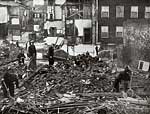 This
destruction was caused during the last bombing raid on Exeter, on the
30th December 1942. Nineteen were killed in total during the tip and
run raid.The rescue workers are shown picking over the ruins
at Holloway Street where there were 12 fatalities.
This
destruction was caused during the last bombing raid on Exeter, on the
30th December 1942. Nineteen were killed in total during the tip and
run raid.The rescue workers are shown picking over the ruins
at Holloway Street where there were 12 fatalities.
 An interesting view across St Sidwells
with Summerland Street on the right. The Sidwell Street Methodist
Church and the Odeon Cinema can be clearly discerned on the line of
Sidwell Street. Odd buildings survived in the centre of the devastated
area. The photograph was taken from Belgrave Road, now Western Way,
some time after the raid, as the rubble has been cleared.
An interesting view across St Sidwells
with Summerland Street on the right. The Sidwell Street Methodist
Church and the Odeon Cinema can be clearly discerned on the line of
Sidwell Street. Odd buildings survived in the centre of the devastated
area. The photograph was taken from Belgrave Road, now Western Way,
some time after the raid, as the rubble has been cleared.
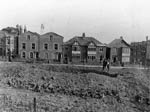 Even right out at Union Road,
Pennsylvania, the locals did not escape the bombers. This photo shows
the result of a bomb dropped on the 23rd April 1942. Blast damage to
some of the houses in the road can be clearly seen, along with the bomb
crater that produced the damage. The photograph was taken some time
after the event, as it has been tidied up. Photo courtesy of Tony
Lethbridge.
Even right out at Union Road,
Pennsylvania, the locals did not escape the bombers. This photo shows
the result of a bomb dropped on the 23rd April 1942. Blast damage to
some of the houses in the road can be clearly seen, along with the bomb
crater that produced the damage. The photograph was taken some time
after the event, as it has been tidied up. Photo courtesy of Tony
Lethbridge.
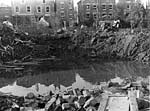 As
a companion to the previous photograph, this shows another water filled
bomb crater in Union Road. Photo courtesy of Tony
Lethbridge.
As
a companion to the previous photograph, this shows another water filled
bomb crater in Union Road. Photo courtesy of Tony
Lethbridge.
│ Top of Page │